2. 中国石化胜利油田有限公司物探研究院, 山东东营 257022;
3. 中国科学院地质与地球物理研究所, 北京 100029
2. Shengli Geophysical Research Institute of China Petrochemical Corporation (SINOPEC), Shandong Dongying 257022, China;
3. Institute of Geology and Geophysics, Chinese Academy of Sciences, Beijing 100029, China
实现地震资料反演是确定地层岩性、识别储层流体、提高地震解释精度的重要方法和途径[1~8],因此地层密度和岩石物理参数反演一直是地震反演的热点问题之一[9~18].Zoeppritz方程是AVO(Amplitude Versus Offset)或AVA(Amplitude Versus incident Angle)反演技术的基础[11~18].但由于方程解的复杂性,致使目前的AVO(或AVA)反演几乎都是基于Zoeppritz方程近似实现的,适应于弱反射介质界面、小偏移距反射问题.但在实际勘探中已遇到了大量的非弱反射界面(包括小角度范围)及大角度甚至是广角反射问题[19~31](井间地震、深水探区等),这些问题难以满足Zoeppritz方程近似式成立的条件[19~21, 24~30],这种近似会给计算带来较大的误差,不能满足勘探开发对计算的需求,需要寻找更准确的反演计算方法,拓展叠前反演方法的使用范围,提高计算精度.因此研究基于Zoeppritz方程的反演偏导矩阵高精度计算方法十分必要.文献[31]给出了地震波反射系数对地层纵横波速度导数的准确计算方法,实现了反演纵横波速度偏导矩阵的准确计算[31],但没有给出地震波反射系数对地层密度偏导数的计算方法.因在地震波速度中隐含着介质的密度,使计算反射系数对地层介质密度比偏导数复杂化,更增加了利用反射系数反演介质密度的难度.但由于地层密度是反映地层岩性十分重要的参数,因此在不简化Zoeppritz方程条件下开展包括适合于大角度反射问题的地层密度反演将具有实际意义,其关键是偏导矩阵精确计算的实现.在Zoeppritz方程中由于反射系数与介质密度是一个十分复杂的非线性关系,因此在许多反演计算中往往将反射界面两侧介质的密度比作为一个变量研究.本文基于这一思路以精确求解Zoeppritz方程为手段,实现了用于反演介质密度比偏导矩阵的精确计算,克服了Zoeppritz方程近似式所遇到的困难,为进一步利用反射系数反演地层介质密度及解决大角度入射波反演问题提供了重要的理论依据.
2 反演介质密度比的偏导矩阵方程如图 1,其中p,sv分别表示p,sv地震波.α为p波入射角,β为转换波sv的反射角;α′,β′分别为透射p,sv波的折射角;vp1、vs1、ρ1、vp2、vs2、ρ2分别为波在介质1、2中的p、sv波的速度和介质的密度.
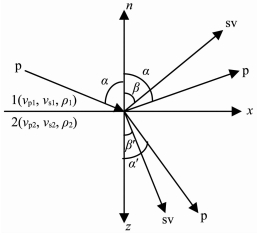
|
图 1 P波在界面的反射和透射 Fig. 1 Reflection and refraction of a P-wave at an interface between two elastic media |
在边界地震波满足位移和应力连续的Zoeppritz方程[7, 8]

|
(1) |
其中
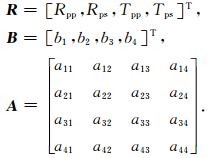
|
(2) |
Rpp、Rps、Tpp、Tps分别为入射p波、反射p,sv波和折射p、sv波的反射和折射系数.在公式(2)中上标T表示矩阵的转置,

|
设在反射界面两侧介质的密度比为ρ21=ρ2/ρ1,将Zoeppritz方程两边对ρ21求导得

|
(3) |
在(3)式中矩阵A与入射角有关.利用Zoeppritz方程(1)可计算反射系数R,只要计算出
在同一种均匀弹性介质中纵横波速度分别为

|
(4) |
其中K,μ分别为弹性介质的体变弹性模量和切变弹性模量,ρ为介质的密度.若两种介质的密度比为ρ21=ρ2/ρ1,则有

|
(5) |

|
(6) |
因

|
由(4)式知

|
而

|
同理

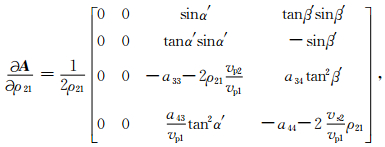
|
(7) |
其中

|
将矩阵形式的Zoeppritz方程(1)的第4行的矩阵元素a43、a44除以vp1并对ρ21求导得
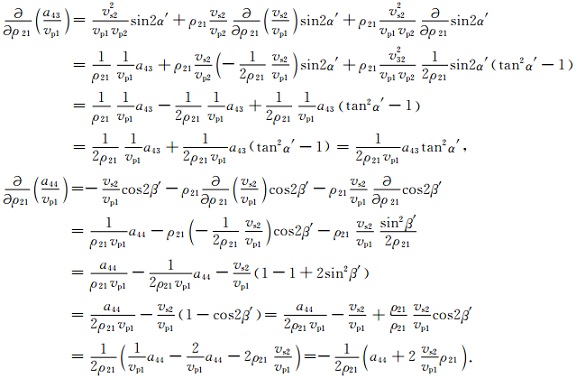
|

矩阵B各矩阵元为

|
因在计算



|
(8) |
为对反射系数对介质密度比偏导数给出一个直观的认识和了解,选择文献[8](陆基孟1993,P166)中算例参数,分别计算了反射系数对介质密度比的偏导数.当vp2>vp1时参数取值为[8]:vp1=3500 m/s,vp2=vp1/0.62=5645 m/s;vs1=vp1/1.7=2058m/s,vs2=vp2/1.7=3320m/s;ρ2/ρ1=1.266.第一临界角αc=38.316°,在所选参数条件下不存在第二临界角.图中字符表示:

图 2为入射p-波,反射p-波反射系数对ρ21的导数曲线(导数的大小,即导数的模).曲线在第一临界角(算例αc=38.316°)处存在锐峰(实际上是间断点,在αc点

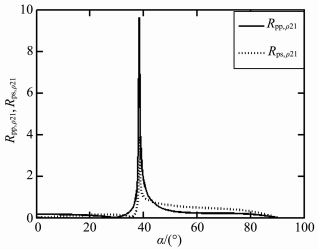
|
图 2
反射系数Rpp、Rps对介质密度比ρ21的导数( |
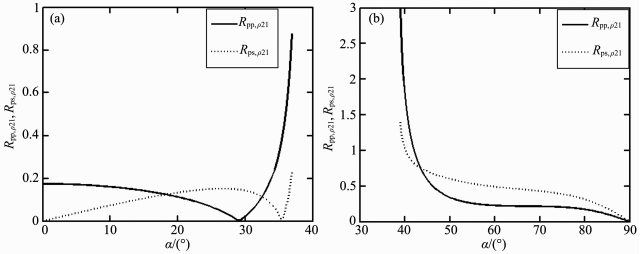
|
图 3 反射系数Rpp、Rps对介质密度比ρ21的导数 Fig. 3 Partial derivatives of reflection coefficients Rpp and Rps with respect to ρ21 |

|
图 4 反射系数Rpp、Rps对介质密度比ρ21导数的实部和虚部 Fig. 4 Real and imaginary parts of partial derivatives of reflection coefficients Rpp and Rps with respect to ρ21 |
图 5是透射系数Tpp、Tps对介质密度比ρ21的导数,与图 2类似在临界角附近曲线变化比较剧烈.

|
图 5 透射系数Tpp、Tps对介质密度比ρ21的导数 Fig. 5 Partial derivatives of refraction coefficients Tpp and Tps with respect to ρ21 |
上面的计算表明(图 2~图 5)反射系数对密度比的导数在第一临界角均存在异常,第一临界角是Rpp、Rps对介质密度比ρ21导数的间断点,是Rpp、Rps对介质密度比ρ21导数曲线的折点,形成了明显的临界角标志,这可被用于反射波临界角的识别,也可被用于研究反射界面两侧介质密度的变化.
5 结论由Zoeppritz方程通过对方程求导建立了反演介质密度比的偏导方程,导出了Zoeppritz方程各矩阵元对介质密度比的偏导数.通过求解偏导方程实现了反演介质密度比偏导矩阵的精确计算,克服了目前AVO(或AVA)反演使用Zoeppritz方程近似所遇到的困难.该方法不仅适应于弱反射介质界面和小偏移距反射问题,而且还适用于非弱反射界面及大角度反射问题,扩大了使用范围.利用算例还分析了反射系数对介质密度比偏导数的特点,结果显示:反射系数对介质密度比的导数在第一临界角曲线存在间断点,形成了明显的临界角标志,这一特点在对大角度反演问题值得注意;当入射角大于第一临界角后反演偏导矩阵变为复数,其实部和虚部包含了大量的地层岩石物性参数信息,各自的地球物理意义、在反演中如何应用有待于更为深入的研究.反演介质密度偏导矩阵精确计算的实现,为优化选择反演角度,消除反射系数及反射系数偏导数出现奇异和接近零的反演角度,建立多角度反演方法,为进一步实现地层介质密度反演,提高计算速度和反演精度将具有重要的实际意义.
| [1] | Batzle M, Wang Z. Seismic properties of pore fluids. Geophysics , 1992, 57: 1396-1408. DOI:10.1190/1.1443207 |
| [2] | Han D H, Nur A, Morgan D. Effects of porosity and clay content on wave velocities in sandstones. Geophysics , 1986, 51: 2093-2107. DOI:10.1190/1.1442062 |
| [3] | Keys R G, Xu S Y. An approximation for the Xu-White velocity model. Geophysics , 2002, 67: 1406-1414. DOI:10.1190/1.1512786 |
| [4] | Kuster G T, Toks z M N. Velocity and attenuation of seismic waves in two phase media:Part I:Theoretical formulation. Geophysics , 1974, 39: 587-606. DOI:10.1190/1.1440450 |
| [5] | White L, Castagna J. Stochastic fluid modulus inversion. Geophysics , 2002, 67: 1853-1843. DOI:10.1190/1.1527085 |
| [6] | Xu S, White R E. A new velocity model for clay-sand mixtures. Geophysical Prospecting , 1995, 43: 91-118. DOI:10.1111/gpr.1995.43.issue-1 |
| [7] | Fred J H著.地震振幅解释.孙夕平, 赵良武译.北京:石油工业出版社, 2006:18~39 Fred J H. Seismic Amplitude Interpretation (in Chinese). Sun X P, Zhao L W trans. Beijing:Petroleum Industry Press, 2006:18~39 |
| [8] | Lu J M. Seismic Exploration Principle (the First and Second Volumes). Shandong Dongying:China University of Petroleum Press , 1993. |
| [9] | Xu S, White R E. A physical model for shear-wave velocity prediction. Geophysical Prospecting , 1996, 44: 687-717. DOI:10.1111/gpr.1996.44.issue-4 |
| [10] | Shuey R T. A simplification of the Zoeppritz-equations. Geophysics , 1985, 50(3): 609-614. |
| [11] | 马在田. P-SV反射转换波的倾角时差校正(DMO)方法研究. 地球物理学报 , 1996, 39(2): 243–250. Ma Z T. DMO for P-SV converted reflection. Chinese J. Geophys. (in Chinese) , 1996, 39(2): 243-250. |
| [12] | 李景叶, 陈小宏, 郝振江, 等. 多波时移地震AVO反演研究. 地球物理学报 , 2005, 48(5): 902–908. Li J Y, Chen X H, Hao Z J, et al. A study on multiple time-lapse seismic AVO inversion. Chinese J. Geophys. (in Chinese) , 2005, 48(5): 902-908. |
| [13] | 孟宪军, 姜秀娣, 黄捍东, 等. 叠前AVA广义非线性纵横波速度反演. 石油地球物理勘探 , 2004, 39(6): 645–650. Meng X J, Jiang X D, Huang H D, et al. Generalized non-linear P wave and S wave velocity inversion of prestack AVA. Oil Geophysical Prospecting (in Chinese) , 2004, 39(6): 645-650. |
| [14] | Shou H, Liu H, Gao J H. AVO inversion based on common shot migration. Applied Geophysics , 2006, 3(2): 99-104. |
| [15] | 顾汉明, 王家映, 江涛, 等. 海底多波多分量AVO蕴含弹性参数信息的定量分析. 石油地球物理勘探 , 2000, 35(1): 56–63. Gu H M, Wang J Y, Jiang T, et al. Quantitative analysis of elastic parameter information contained in AVO of sea-bottom multi-wave multi-component seismic data. Oil Geophysical Prospecting (in Chinese) , 2000, 35(1): 56-63. |
| [16] | 陈建江, 印兴耀, 张广智. 层状介质AVO叠前反演. 石油地球物理勘探 , 2006, 41(6): 656–662. Chen J J, Yin X Y, Zhang G Z. Prestack AVO inversion of layered medium. Oil Geophysical Prospecting (in Chinese) , 2006, 41(6): 656-662. |
| [17] | 王保丽, 印兴耀, 张繁昌. 基于Gray近似的弹性波阻抗方程及反演. 石油地球物理勘探 , 2007, 42(4): 435–439. Wang B L, Yin X Y, Zhang F C. Gray approximation-based elastic wave impedance equation and inversion. Oil Geophysical Prospecting (in Chinese) , 2007, 42(4): 435-439. |
| [18] | 丁继才, 常旭, 刘伊克, 等. 基于声波方程的井间地震数据快速WTW反演方法. 地球物理学报 , 2007, 50(5): 1527–1533. Ding J C, Chang X, Liu Y K, et al. Rapid method for acoustic wave-equation WTW inversion of cross-hole seismic data. Chinese J. Geophys. (in Chinese) , 2007, 50(5): 1527-1533. |
| [19] | Brittan J, Warner M. Wide-angle seismic velocities in heterogeneous crust. Geophysics Journal International , 1997, 129(2): 269-280. DOI:10.1111/gji.1997.129.issue-2 |
| [20] | Zhang W P, Guo P, Hu T Y. Study and practice of wide-angle seismic data processing. Applied Geophysics , 2004, 1(1): 31-37. DOI:10.1007/s11770-004-0026-9 |
| [21] | Fruehn J, White R S, Fliedner M, et al. Large-aperture seismic:imaging beneath high-velocity strata. World Oil , 1999, 220(1): 109-113. |
| [22] | 刘福平, 李瑞忠, 杨长春, 等. 非均匀P-偏振电磁波在导电界面的类全反射横向偏移. 地球物理学报 , 2007, 50(2): 556–566. Liu F P, Li R Z, Yang C C, et al. The lateral shift of quasi total reflection of inhomogeneous P-electromagnetic wave on the interface of conductive media. Chinese J. Geophys. (in Chinese) , 2007, 50(2): 556-566. |
| [23] | Liu F P, Wang A L, Chen Q, et al. The research progress on lateral shift of reflected electromagnetic wave at the interface of two conductive media. Chinese Science Bulletin , 2008, 53(7): 961-968. |
| [24] | 胡中平, 管路平, 顾连兴, 等. 高速屏蔽层下广角地震波场分析及成像方法. 地球物理学报 , 2004, 47(1): 88–94. Hu Z P, Guan L P, Gu L X, et al. Wide angle seismic wave field analysis and imaging method below the high velocity shield layers. Chinese J. Geophys. (in Chinese) , 2004, 47(1): 88-94. |
| [25] | 李怀胜. 广角反射在塔中地区的应用. 石油物探 , 2005, 44(3): 292–295. Li H S. The application of wide-angle reflection method in central Tarim basin. Geophysical Prospecting for Petroleum (in Chinese) , 2005, 44(3): 292-295. |
| [26] | 王志, 贺振华, 黄德济, 等. 高速屏蔽层下弱反射层地震勘探--广角反射. 勘探地球物理进展 , 2002, 25(5): 23–27. Wang Z, He Z H, Huang D J, et al. A seismic survey method for weak reflectors below shielded layer of high velocity:wide angle reflection. Progress in Exploration Geophysics (in Chinese) , 2002, 25(5): 23-27. |
| [27] | 孙成禹, 倪长宽, 李胜军, 等. 广角地震反射数据特征及校正方法研究. 石油地球物理勘探 , 2007, 42(1): 24–29. Sun C Y, Ni C K, Li S J, et al. Feature of wide-angle reflection data and correction method. Oil Geophysical Prospecting (in Chinese) , 2007, 42(1): 24-29. |
| [28] | 王志, 贺振华, 黄德济, 等. 广角反射波场特征研究及正演模拟分析. 地球物理学进展 , 2003, 18(1): 116–121. Wang Z, He Z H, Huang D J, et al. The wave-field features researching of wide-angle reflection and the analyzing of forward modeling. Progress in Geophysics (in Chinese) , 2003, 18(1): 116-121. |
| [29] | 徐文君, 於文辉, 胡中平. 广角反射波的特征及正演模拟. 石油地球物理勘探 , 2006, 41(4): 390–395. Xu W J, Yu W H, Hu Z P. Feature and forward simulation of wide-angle reflection. Oil Geophysical Prospecting (in Chinese) , 2006, 41(4): 390-395. |
| [30] | 王彦飞. 反演问题的计算方法及其应用--当代科学前沿论丛. 北京: 高等教育出版社, 2007 : 31 -84. Wang Y F. Computational Method for Inverse Problem and Their Applications (in Chinese). Beijing: Higher Education Press, 2007 : 31 -84. |
| [31] | 刘福平, 孟宪军, 王玉梅等.反演纵横波速度的Jacobi矩阵及精确计算方法.中国科学D, 2010, 40(9):(待发表) Liu F P, Meng X J, Wang Y M, et al. Jacobian matrix for the inversion of P-and S-wave velocities and its accurate computation method. Science in China (Series D), 2010, 40(9):(in press) |
 2010, Vol. 53
2010, Vol. 53

